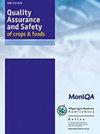香芹酚与ε-聚赖氨酸的协同抗菌作用
IF 5.3
3区 农林科学
Q1 FOOD SCIENCE & TECHNOLOGY
引用次数: 4
摘要
本研究旨在评估聚赖氨酸(-PL)和香芹酚(Car)组合对食源性病原体大肠杆菌和金黄色葡萄球菌的抗菌效果。对E。coli和S。金黄色葡萄球菌分别为25μg/mL(320μg/mL)和12.5μg/mL。棋盘格分析表明,-PL和Car的组合对E。coli和S。部分抑制浓度指数(FICI)分别为0.375和0.5。结果表明,与单一处理相比,-PL和Car的组合显著抑制了两个菌株的生长。μg/mL或Car(80μg/mL)对E。coli和S。通过评估金黄色葡萄球菌在细胞膜完整性、膜通透性、呼吸活性和膜结构方面的变化,对其进行了研究。与单独使用-PL或Car相比,-PL和Car的组合增加了对细胞膜的损伤及其渗透性,并导致260nm吸收材料的释放,降低了呼吸链脱氢酶活性。这些结果表明,-PL和Car的组合可以作为一种新的有前景的天然食品防腐剂。本文章由计算机程序翻译,如有差异,请以英文原文为准。
Synergistic antibacterial effects of carvacrol and ε-polylysine
This study aimed to evaluate the antimicrobial efficacy of the combination of ɛ-polylysine (ɛ-PL) and carvacrol (Car) against foodborne pathogens, Escherichia coli and Staphylococcus aureus. The minimum inhibitory concentrations (MICs) of ɛ-PL (Car) against E. coli and S. aureus were 25 μg/mL (320 μg/mL) and 12.5 μg/mL (320 μg/mL), respectively. Checkerboard assays showed that the combination of ɛ-PL and Car exerted synergistic effects against E. coli and S. aureus with fraction inhibitory concentration index (FICI) of 0.375 and 0.5, respectively. It demonstrated that the combination of ɛ-PL and Car significantly inhibited the growth of the two strains compared to single treatment. Furthermore, the mode of action of ɛ-PL (6.25 μg/mL) or Car (80 μg/mL) in inhibiting E. coli and S. aureus was researched by assessing their changes with regard to cellular membrane integrity, membrane permeability, respiratory activity, and membrane structure. A combination of ɛ-PL and Car increased the damage to cell membranes and their permeability and led to the release of 260 nm absorbing materials, decreased respiratory-chain dehydrogenase activity compared with ɛ-PL or Car treatment alone. These results demonstrated that the combination of ɛ-PL and Car could be used as a new promising naturally sourced food preservative.
求助全文
通过发布文献求助,成功后即可免费获取论文全文。
去求助
来源期刊

Quality Assurance and Safety of Crops & Foods
FOOD SCIENCE & TECHNOLOGY-
CiteScore
4.60
自引率
7.50%
发文量
61
审稿时长
1 months
期刊介绍:
''Quality Assurance and Safety of Crops & Foods'' is an international peer-reviewed journal publishing research and review papers associated with the quality and safety of food and food sources including cereals, grains, oilseeds, fruits, root crops and animal sources. It targets both primary materials and their conversion to human foods. There is a strong focus on the development and application of new analytical tools and their potential for quality assessment, assurance, control and safety. The scope includes issues of risk assessment, traceability, authenticity, food security and socio-economic impacts. Manuscripts presenting novel data and information that are likely to significantly contribute to scientific knowledge in areas of food quality and safety will be considered.
''Quality Assurance and Safety of Crops & Foods'' provides a forum for all those working in the specialist field of food quality and safety to report on the progress and outcomes of their research.
 求助内容:
求助内容: 应助结果提醒方式:
应助结果提醒方式:


